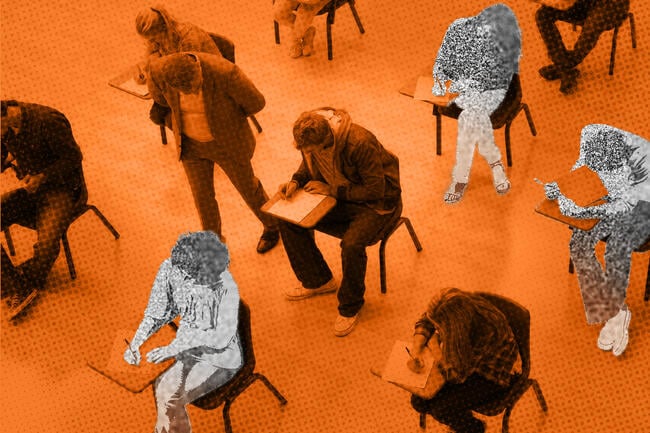You have /5 articles left.
Sign up for a free account or log in.

California Community Colleges are working to excise “ghost students” from their class rosters.
Faced with an ongoing swell of fraudulent applications and enrollments, the California Community College system is hotly debating what to do next to win their battle against bot “students” for good.
Since the COVID-19 pandemic, the 116-college system has been haunted by ghost students—impostors who enroll online, apply for financial aid and disappear with the funds. System administrators say the issue arose in the last five years, with fraudsters eager to access federal aid made available to students. The growth of online education and spread of AI has exacerbated the problem, making it easier for bots to apply in droves. The issue has put strain on professors and staff who have had to flag and purge thousands of bots from online courses and led to the loss of millions of dollars of student aid.
System leaders brought a proposal before the Board of Governors in a meeting Tuesday, asking them to consider a “nominal” student fee to help pay for artificial intelligence tools and other defenses against the bots. After more than two hours of discussion, board members opted against taking steps to charge a fee. But the board didn’t reject the idea outright; instead they asked system staff to further “explore” it and unanimously voted in favor of other recommendations. Notably, the system now has approval to require an identity-verification process for all applicants and to ramp up use of high-tech and AI tools to combat the issue.
Over the past year alone, the system found 31.4 percent of applications were fraudulent, system officials said. Ghost students have stolen about $10 million in federal financial aid and $3 million in state and local aid in the past year, according to system officials. That’s an escalation from prior years; campus reports obtained by Cal Matters revealed that between September 2021 and January 2024, fraudsters took off with $5 million in federal aid and $1.5 million in state and local aid.
Those figures have alarmed state lawmakers. Last month, nine Republican members of Congress from California sent a letter to Education Secretary Linda McMahon and Attorney General Pam Bondi calling for a federal investigation into the fraud issue. State lawmakers, Republicans and Democrats alike, have since demanded a state audit of the system’s fraud challenges.
Chris Ferguson, executive vice chancellor of the California Community College system, told Inside Higher Ed that stolen funds account for “about two-tenths of a percent” of the several billion dollars of aid flowing into the colleges, “well below the threshold that would normally trigger federal investigations of financial aid fraud,” he said. He also emphasized that the system’s current tools for fraud detection capture about 85 percent of false applications.
At the beginning of last year, the system rolled out a new identity verification process as a part of applications, called ID.me. But the process was optional for community college districts until the Board of Governors voted to require it at this week’s meeting.
Ferguson would like to see the share of fraudulent cases caught—and prevented—approach 100 percent, partly by scaling AI tools already in use on some campuses. But advancing those efforts could cost up to $10 million, Ferguson estimated, which is why administrators requested the authority to charge a student fee in “the low tens of dollars.”
The goal of the fee would be to “both support application review costs and deter fraudulent application submissions,” according to the proposal.
James Todd, assistant vice chancellor of the California Community College system, told Inside Higher Ed that the system is trying to prevent fake students from continuing to take away resources from real students. He said campus employees have had to pivot from their day-to-day, student-facing work to focus their attention on identifying bots. Meanwhile, ghost students’ registrations are crowding out actual students from classes they need for their programs.
“Our entire system is based on increasing equitable access for students,” Todd said. “Students who are already on a degree or certificate path are sometimes finding barriers to being able to enroll in a class or a class being canceled because colleges have found that it’s all enrolled with fraudulent students. That is what we’re dealing with on an everyday basis across our campuses.”
But students came out in force at the Board of Governors meeting to express their opposition to the fee. Many students, from campuses across the system, acknowledged the importance of rooting out ghost students but also shared concerns that an additional charge, even if small, could pose a financial barrier for low-income students.
The fee “is someone’s food, is someone’s gas,” Daniela Romo, president of the Associated Students of Delta College at San Joaquin Delta College, told the board. “But it’s also a message to other people that there is some barrier to entry … I think that the beauty of the California Community College system is that it accepts everybody with open arms.”
A National Issue
While California community colleges have a particularly stubborn bot problem, student aid fraud isn’t new or isolated to the system.
The Office of Inspector General at the federal Department of Education has been working for years to raise national awareness about financial aid fraud rings. For example, OIG investigations revealed $10 million worth of student aid fraud in Michigan, Mississippi, North Carolina and other states, according to a 2021 report.
Community colleges tend to be the most vulnerable to these types of scams because of their open-access mission, said Jill Desjean, director of policy analysis at the National Association of Student Financial Aid Administrators. They intentionally make it easy for students to apply, unlike more selective universities, and they’re low-cost, or even no cost in states with free college programs. That means a fraudulent student who feigned eligibility for the Pell Grant could pay minimal tuition and pocket the rest of the aid money intended for other educational expenses like textbooks and transportation.
“Because of their very nature of being welcoming to all, [community colleges] invite this kind of opportunity for fraud,” Desjean said.
She emphasized that there are guardrails in place to prevent people from exploiting the financial aid system, like the FAFSA verification process, which requires some students to verify information on their financial aid applications. The Department of Education also flags potentially fraudulent behavior, like enrolling and withdrawing multiple times at different nearby institutions.
But there’s a difficult balance to strike between stopping fraudsters and making the financial aid process so burdensome that real students are deterred from applying, she said.
Adu Love, a student member of the Board of Governors, raised similar concerns about the community college system’s verification process, now required for all applicants. She told the board she worries extra steps could make applying more difficult for homeless, incarcerated or undocumented students, who might lack some of the necessary documentation. She herself drove five hours to Moorpark College to verify her identity because she was unable to use ID.me, she said.
“Our responsibility is not just to stop fraud, but it’s also to maintain the access we have as a system while we do it,” she told board members.
Using AI to Fight AI?
Earlier in the Board of Governors meeting, some community college leaders detailed the stress fraudulent applications have put on their campuses and the steps they’ve taken to resolve the issue.
Jeannie G. Kim, president of Santiago Canyon College, told the board that her institution identified about 10,000 fraudulent students by employing various verification methods, including making phone calls to individual students.
“We had to actually take them out of our system, and when we did that, of course, our enrollment numbers … dropped tremendously,” Kim said. “But we needed to do it, because we needed to bring our real students in. That saved the day for our students … Our students were clamoring for these classes that they could not gain access to.”
Clearing out the false students made room for about 8,000 actual students to enroll.
Jory Hadsell, vice chancellor of technology for the Foothill–De Anza Community College District, told the Board of Governors that “waves” of fraudulent applications last year left admissions and financial aid personnel “overwhelmed and exhausted” as they sifted through thousands of suspect applications.
“Internal fraud tools were no longer keeping up with the speed and the sophistication of the threat that we were facing,” he said.
Now the Foothill–De Anza district and Santiago Canyon are part of a group of 48 colleges that have turned to artificial intelligence to flag potentially fraudulent applications—and they say it’s working.
Kim told board members that AI has been a game changer, helping her college catch bots at the application stage and keep them out of enrollments and wait lists.
The AI model reviews each application and gives it a “fraud score” indicating how likely it is to be fraudulent, along with an explanation of what factors triggered its suspicions. For example, the AI can detect whether lots of applications are coming from the same IP address.
The fraud problem “is controllable,” Kim said. “We have a 99 percent efficacy rate with the implementation that we have done” for a cost of less than $100,000.
Kiran Kodithala, CEO of N2N Services, which offers LightleapAI, the tool colleges are using, said at the meeting that the company processed roughly three million applications in the last eight months and prevented about 360,000 fraudsters “from defrauding taxpayers, stealing classes from students” and worrying campus leaders, helping them avoid “waking up in the middle of the night” fretting over whether they can trust their enrollment numbers.
These are the kinds of tools Ferguson wants to see expanded to more institutions.
“The more we can stop [fraud] at the application phase, the less you have to do on the enrollment front and … the less you have to do on the financial aid front,” he said.
Kim told the board that not every institution can use the same AI tools, because the bots used for fraud are too “smart”—they’ll quickly adapt if colleges aren’t using a diverse set of defenses. But she believes the entire system should be required to use some form of AI as part of their antifraud strategy, especially lower-resourced institutions that may not have the money or staffing to flag a swell of suspect applications on their own.
“We have a lot of small rural colleges, and those colleges cannot handle the kind of attack that we endured last fall,” she said. “If that happens to them, they are going to be in jeopardy.”





